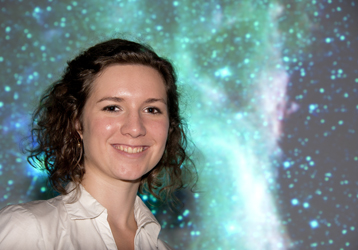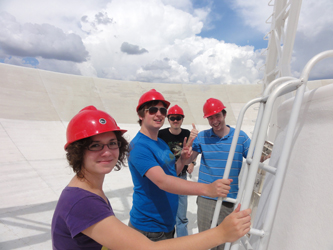A CSIRO Summer Vacation student has uncovered details of how galaxies and their magnetic fields evolve together — one of the most challenging problems in astrophysics.
Claire-Elise Green, a second-year Advanced Science student from the University of New South Wales, has been working at CSIRO Astronomy and Space Science in Sydney for nine weeks.

Claire-Elise Green
“We find magnetic fields throughout space,” Ms Green said. “We know they help stars and planets form, but their role in galaxies is less clear.”
Magnetic fields can be detected with radio telescopes, because of the effect they have on radio waves.
“Just as light can be polarised by our sunglasses, radio waves can be polarised. Magnetic fields change the direction of this polarisation, so by looking at how the waves are polarised, we can determine the direction of the magnetic fields,” explained Ms Green’s supervisor, CSIRO astronomer Dr Julie Banfield.

CSIRO Vacation Students on an antenna of CSIRO's Australia Telescope Compact Array radio telescope, near Narrabri, NSW. L-R: Claire-Elise Green, Doug Compton, Dr Maxim Voronkov (CSIRO staff member), Lewis Freeland.
Magnetic fields in space were discovered decades ago, but only recently has it become possible to study them in very distant galaxies.
Ms Green has been using data from US and Canadian radio telescopes to study 136 distant galaxies whose cores produce huge amounts of energy.
These galaxies, called “active galactic nuclei” or AGN, are scattered all across the Universe and are at different stages in their development.
“I’m looking to see if the magnetic fields differ in the different types of these galaxies,” she said.
“For instance, I’ve been looking to see where the magnetic fields start from — the centre of the galaxy, or its outer parts — and whether the magnetic field gets more ordered or changes orientation as galaxies get older.”
“What we knew before going into this project is that magnetic fields appear to evolve with galaxy evolution, but we didn’t know why or how,” said Dr Banfield.
“What Claire-Elise has found is that the location of the magnetic field changes as an AGN evolves from one type to another.”
During her time at CSIRO Ms Green has visited the Australia Telescope Compact Array, at Narrabri, NSW, getting the chance to explore galaxies ‘hands on’ at a telescope as well as from her computer in Marsfield, Sydney.
Ms Green said her vacation scholarship at CSIRO has been an invaluable experience, allowing her to see what astrophysicists do on a day-to-day basis and to learn from and work with them on real-world problems.
Media Note
Claire-Elise is one of more than 110 mathematics, ICT and astronomy students wrapping up their summer with CSIRO at the Big Day In on 2 – 3 February at Macquarie University in Sydney. The Big Day In provides students with the opportunity to give a presentation about their vacation project and hear talks from senior CSIRO scientists.
Contact: Helen Sim. Ph: +61 2 93724251. Mb: 0419 635 905. E: helen.sim@csiro.au

